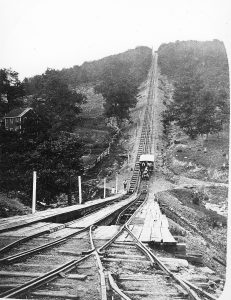Celebrating America’s First Railroad: the Switchback
Written by Martha Capwell Fox, DLNHC Historian
May 11 is National Train Day. That makes it the perfect day to celebrate America’s first railroad, the Mauch Chunk Gravity Railroad, better known as the Switchback.
The Gravity Railroad was the key to moving anthracite coal swiftly and efficiently from the first mine on top of Sharp Mountain (now Summit Hill, PA) to the banks of the Lehigh River at Mauch Chunk, nine miles away and nearly 1000 feet lower. Built in 1827, it was an engineering marvel built on an even earlier engineering marvel—the stone-paved Coal Road that was built in 1818-19. 
This was the first US road built with a standard declivity, a continuous grade of 75 to 100 feet per mile. Because it did not rise and fall with the terrain and had a smooth and solid surface, wagons carrying coal could move faster down and up between the mine and the river, delivering more coal at lower cost.
Innovative as it was, the Coal Road was just the first step in the plan that Josiah White and Erskine Hazard, the founders of the Lehigh Coal & Navigation Company (LC&N), had for building the even more revolutionary gravity railroad. But the LC&N corporate directors in Philadelphia worried the risk of a new transport system was not worth the cost.
Quietly defying their qualms, White began building the Gravity Railroad in January 1827. Because it was laid over the Coal Road, it was completed in only three months. On May 5, 1827, seven cars carrying anthracite and passengers including Josiah White descended from the mine to Mauch Chunk.
The Gravity Railroad was the first in America to be more than five miles long and to carry significant amounts of heavy freight. Immediately proving its worth, it made multiple round trips per day from the mine to the river possible, instead of just one. Descending took only thirty minutes, though the mules still needed two and a half hours to haul empty cars back up to the mine; the mules rode down in a special car with feed troughs. This moved much more coal and lowered the cost per ton by one-third.
People clamored to ride the Gravity Railroad like the mules. LC&N added open passenger cars and Mauch Chunk became a popular tourist destination.
 The Gravity Railroad became the Switchback in the 1840s, after LC&N expanded its mining operations to cover the cost of repairing the flood-and- ice-damaged Lehigh Navigation. A “back track” was constructed to return empty cars back to the mines by means of steam-powered inclined planes; this also gave some new mines direct access to the railroad.
The Gravity Railroad became the Switchback in the 1840s, after LC&N expanded its mining operations to cover the cost of repairing the flood-and- ice-damaged Lehigh Navigation. A “back track” was constructed to return empty cars back to the mines by means of steam-powered inclined planes; this also gave some new mines direct access to the railroad.
The 18-mile-long Switchback Railroad was completed and opened in May 1846. It moved more tons of anthracite faster from the mines and attracted even more visiting riders.
By the late 1869s, the Lehigh Valley and the Lehigh & Susquehanna railroads —the latter owned by LC&N—were carrying anthracite and passengers to and from Mauch Chunk. They brought hordes of tourists looking for spectacular scenery, an exhilarating ride, and to escape from summer heat. In 1869, over 30,000 people rode the Switchback; its increasing popularity and revenue postponed LC&N’s decision to shut it down.
By 1872, railroads connected the mines directly to canal boats and markets and ended the need to move anthracite on the Switchback. However, the influx of even more thrill-seeking passengers saved the Switchback, and Mauch Chunk remained a popular destination into the first decade of the 20th century. In 1884, it inspired the first amusement park roller coaster when the aptly named “Switchback Railway” opened at Coney Island in New York. But electric trolley lines built in the 1890s and early 1900s lured visitors and excursion groups to nearby Flag Staff Park, which offered amenities including a restaurant, picnic groves, and a dance pavilion coupled with the same spectacular views the Switchback offered.
Fewer riders meant less revenue to maintain the Switchback and its active seasons grew shorter. The last ride on July 4, 1932, carried only 139 people. In 1937, the railroad was sold at auction for scrap.
In the 1970s, revived interest and action for preserving the route of the Switchback led to the creation of the Switchback Trail with land deeded to Carbon County. It was declared a National Historic Recreation Trail in 1980.The section of it that begins below the dam at Mauch Chunk Lake follows part of the original stone Coal Road, where you can still see the continuous grade, and the ground still glitters with anthracite dust.
To learn more: The Mauch Chunk Switchback: America’s Pioneer Railroad by Vincent Hydro, Jr. available at the National Canal Museum Shop or online at store.delawareandlehigh.org
America’s First Roller Coaster: The Summit Hill & Mauch Chunk Gravity Railroad & Switchback, can be purchased directly from the author at Vincent.Hydro@nullgmail.com.
For information about hiking or biking on the Switchback Trail, see https://www.traillink.com/trail/switchback-railroad-trail/























Join the Conversation!